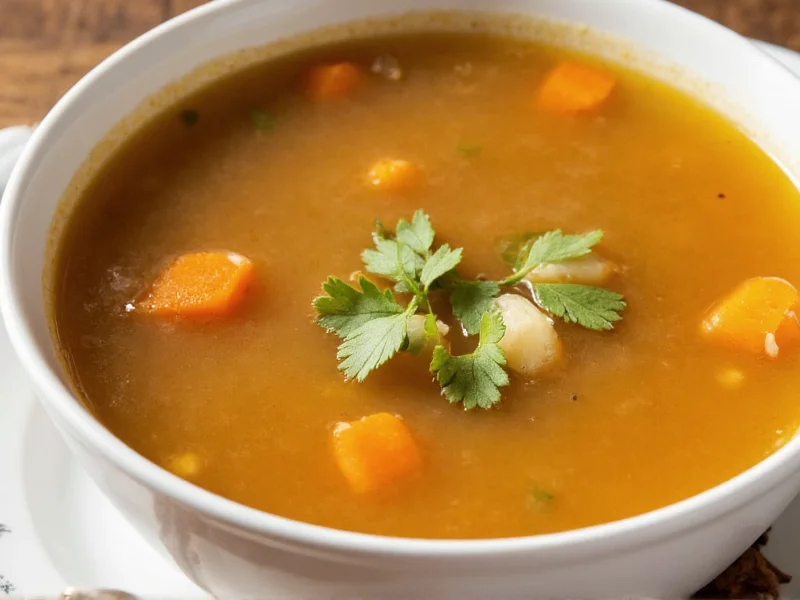Understanding the precise calorie content of bone broth soup is essential for those tracking nutritional intake for weight management, specific diets, or health conditions. This nutrient-dense liquid has gained popularity for its potential health benefits, but accurate calorie information helps consumers make informed dietary choices.
Factors Influencing Calorie Content in Bone Broth
The calorie count in bone broth isn't fixed—it fluctuates based on several preparation variables. Unlike clear consommé or vegetable broth, bone broth derives its nutrition from prolonged simmering of animal bones, which releases collagen, minerals, and small amounts of fat into the liquid.
Bone Selection and Preparation Method
The type of bones used significantly impacts caloric value. Marrow bones contribute more calories than leaner joints or knuckle bones. When making homemade bone broth, roasting bones first enhances flavor but doesn't substantially increase calories. The critical factor is whether you skim the fat layer that forms during simmering—this simple step can reduce calories by 20-30%.
| Bone Broth Type | Calories per 8oz Serving | Primary Calorie Source |
|---|---|---|
| Homemade (skimmed) | 30-40 | Minimal fat, collagen |
| Homemade (unskimmed) | 45-60 | Fat from bones |
| Store-bought low-sodium | 35-50 | Varies by brand |
| Commercial with added oil | 60-75 | Added fats |
Nutritional Profile Beyond Calories
While calorie count matters for dietary planning, bone broth's value extends to its micronutrient profile. A standard serving typically contains:
- 5-10g protein from collagen breakdown
- Trace minerals like calcium, magnesium, and phosphorus
- Negligible carbohydrates (less than 1g per serving)
- Variable fat content (1-5g depending on preparation)
The protein content makes bone broth more satiating than clear broths, which explains its popularity in intermittent fasting protocols where maintaining protein intake while minimizing calories is desirable. When evaluating calories in homemade bone broth soup versus commercial varieties, always check labels for added ingredients that increase caloric density.
Homemade vs. Store-Bought Calorie Comparison
Creating bone broth at home gives you complete control over calorie content. By using lean bones and diligently skimming fat, you can produce a broth with as few as 30 calories per cup. The extended cooking time (12-24 hours) extracts nutrients without adding calories.
Commercial bone broths present more variability. Some brands add sunflower oil or other fats to enhance mouthfeel, significantly increasing calories. When comparing calories in store-bought bone broth soup, check nutrition labels for serving size discrepancies—some list values per 100ml rather than standard 8oz servings, making products appear lower in calories than they actually are.
Serving Size Considerations for Calorie Tracking
Accurate calorie counting requires attention to serving size. Many people consume 16-24 ounces of bone broth in a single sitting, effectively doubling or tripling the listed calorie count. For those following specific dietary protocols like keto or intermittent fasting, understanding calories in large serving bone broth becomes crucial for staying within daily limits.
Dietitians recommend measuring portions rather than estimating, as visual assessment of liquid servings is notoriously inaccurate. A standard measuring cup provides the most reliable method for tracking intake when incorporating bone broth into meal plans.
Integrating Bone Broth into Dietary Plans
The moderate calorie count makes bone broth suitable for various eating patterns. For weight management, it serves as a satisfying low-calorie option that provides more protein than traditional broths. Those following paleo or whole foods diets often use it as a base for soups and stews, where understanding calories in bone broth soup base helps maintain overall meal balance.
Nutrition researchers note that while bone broth isn't a significant protein source compared to meat servings, its amino acid profile—particularly glycine and proline—contributes to its perceived health benefits. The minimal calories combined with these compounds explain its popularity as a pre-bedtime beverage for some wellness-focused individuals.
Practical Tips for Managing Calorie Content
To maintain lower calorie counts in homemade bone broth:
- Use a fat separator when broth is hot but not boiling
- Choose leaner bones like chicken backs rather than marrow bones
- Avoid adding meat during cooking (save for serving)
- Refrigerate finished broth and remove solidified fat layer
- Concentrate flavors with vegetables rather than fats
For those purchasing commercial products, comparing calories in organic bone broth soup versus conventional options reveals minimal difference—the primary variance comes from added ingredients rather than organic certification.
Scientific Perspective on Bone Broth Nutrition
Nutrition science indicates that while bone broth contains valuable compounds, the actual concentration of collagen-derived amino acids in a typical serving may be lower than some wellness claims suggest. A 2022 review in the Journal of Food Science and Nutrition found that an 8oz serving contains approximately 5-7g of protein, primarily from gelatin formed during cooking.
Researchers emphasize that the caloric value remains consistent across preparation methods—the primary variable is fat content. This explains why understanding calories in pressure cooker bone broth soup versus slow-simmered versions shows negligible difference, as the cooking method affects extraction efficiency but not fundamental calorie composition.











 浙公网安备
33010002000092号
浙公网安备
33010002000092号 浙B2-20120091-4
浙B2-20120091-4